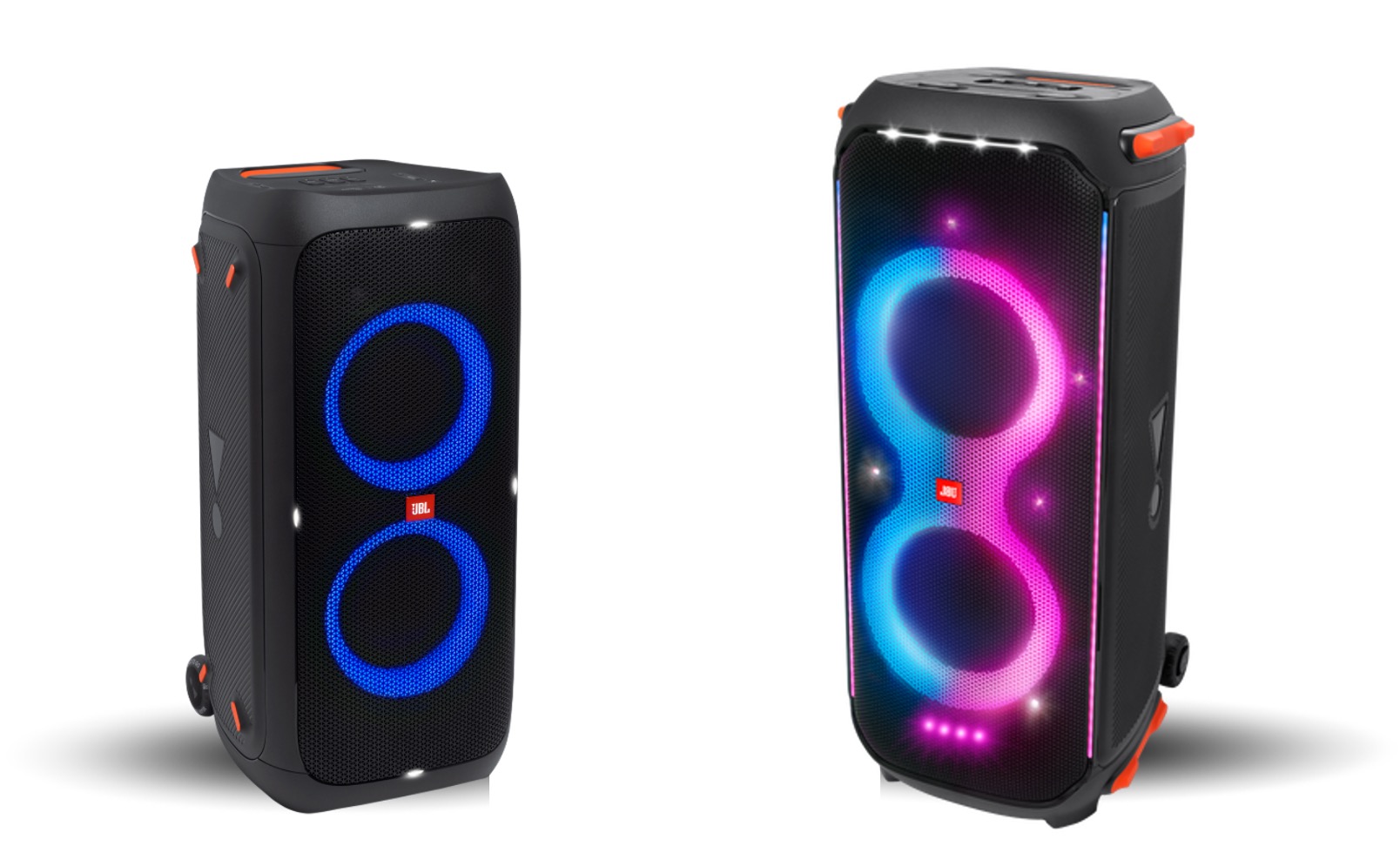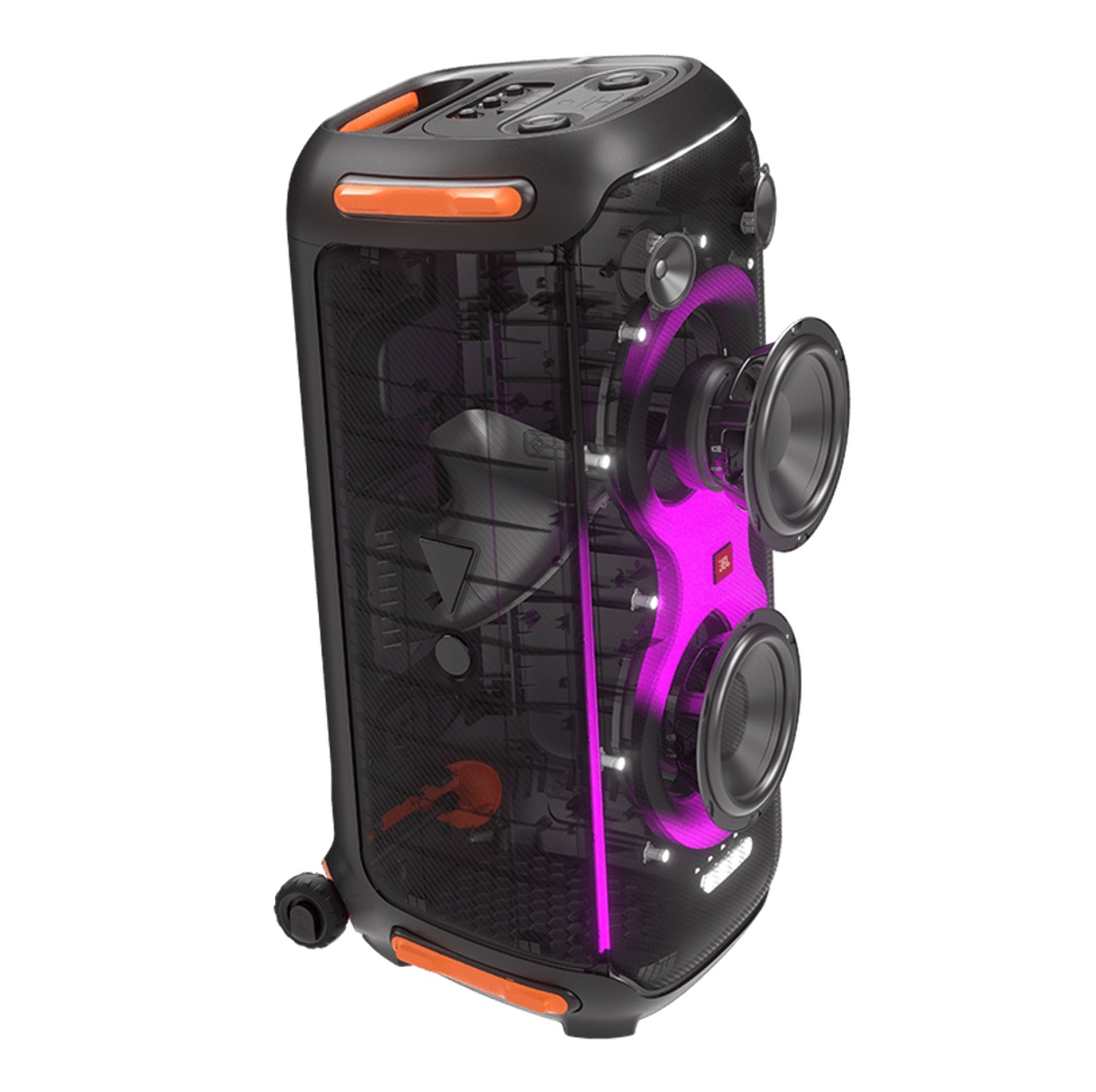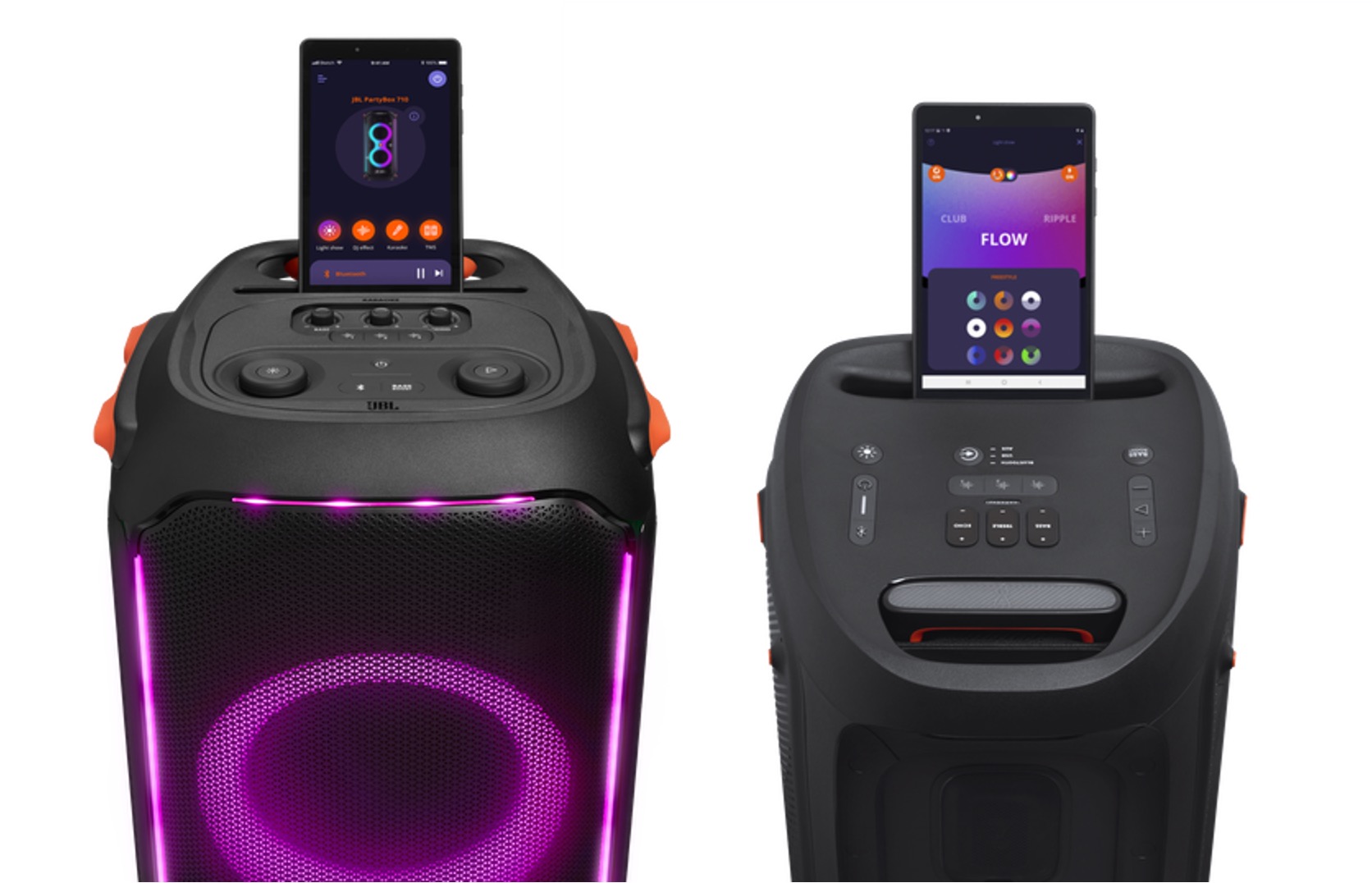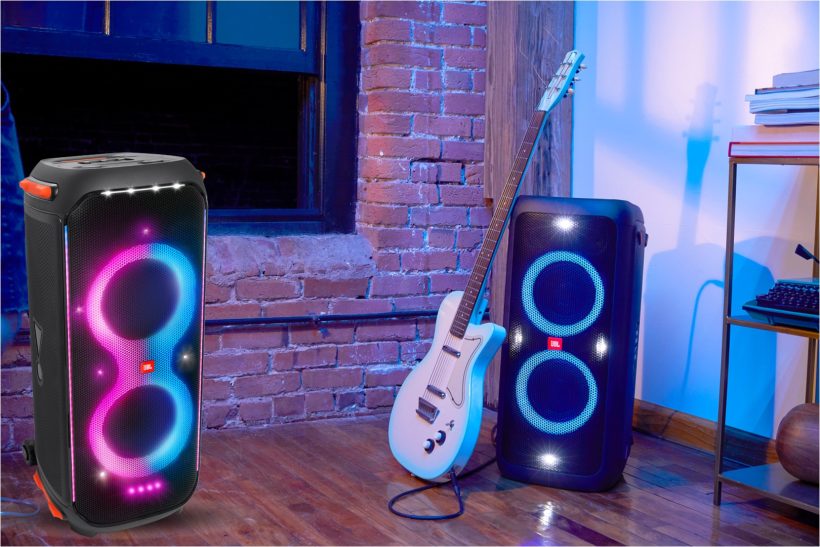The JBL PartyBox 710 and the 310 speaker are some of the loudest portable speakers developed by JBL. Both speakers are extremely loud and powerful, with the JBL PartyBox 710 delivering a massive 800 watts of output power and is currently the second loudest PartyBox currently available from JBL (the loudest being the JBL PartyBox 1000 which has a massive 1100 watts). By comparison, the JBL PartyBox 310 delivers 240 watts of output power, and is designed for smaller outdoor parties and gatherings. Having said that, the PartyBox 310 is still a massive speaker that delivers much more power than the JBL Boombox 3, which has a power output of 136 watts (180 watts peak when connected to AC power). Both the JBL PartyBox 710 and 310 are designed as portable loud outdoor PA systems, with the PartyBox 310 being the entry-level PartyBox that JBL has to offer.
The JBL PartyBox 710 is substantially louder and more powerful than the PartyBox 310 and has a total output power of 800 watts compared with the PartyBox 310’s 240 watts. Both speakers come with dual woofers and tweeters, but the PartyBox 710 has a much larger 8” woofer compared with the PartyBox 310’s 6.5” woofer and slightly larger 2.75” tweeters compared to the PartyBox 310’s 2.5” tweeters. The PartyBox 710 speaker is also capable of producing deeper bass performance with a frequency range down to 35 Hz compared with the PartyBox 310’s 45 Hz, and this has made some appreciable difference in terms of bass output and sound quality.
Having said that, both the PartyBox 710 and PartyBox 310 support Bluetooth 5.1 wireless streaming with A2DP 1.3 and AVRCP 1.6 audio codecs. In terms of portability, the PartyBox 310 is more portable and comes with a built-in battery that delivers a good 12-18 hours of playtime depending on the volume level (around 12 hours at 60% volume continuous). We really liked the fact that both speakers come with JBL dazzling LED light functions which give it a really party and disco vibe, and are great for powering outdoor parties.

Sound Performance
When we compared the JBL PartyBox 710 side by side with the PartyBox 310, it is clear that the PartyBox 710 delivers much louder volume and booming bass. It has a total power output of 800 watts which is the total power out of roughly six JBL Boombox 3 speakers. It also comes with dual 2.75” tweeters and 8 inch woofers that really deliver tremendous bass and crystal clear highs. We played a couple of EDM and hip-hop music soundtracks, including Golden Hour by JVKE and we were blown away by how intense and loud the sound felt. The highs and midranges are surprisingly well-defined, and you get really clean and clear vocals despite the fact that the PartyBox 710’s sound signature is warmer and bass-leaning. We absolutely loved the bass on this speaker – it hits very hard and tight and feels punchy. The bass does not bleed into the midrange frequencies and goes very low with plenty of depth; it feels like the kind of bass that you would hear from a dedicated subwoofer. We also liked the app that comes with the PartyBox 710 which you can use to change the treble, mids and bass-levels, as well as the strobing light effects.
The JBL PartyBox 310, by contrast, does not sound as loud or boomy as the PartyBox 710. It has a power output of 240 watts and has the equivalent power output of two JBL Boombox 3 speakers, which is still very loud but not as powerful as the PartyBox 710. There are some differences in the sound performance between the PartyBox 310 and 710. First, the PartyBox 310 does not deliver bass that sounds as deep as the PartyBox 710. Although the bass response is good, it feels not as well-rounded and deep as the PartyBox 710 – the bass on the 710 feels like bass from a real subwoofer rather than just bass reflex ports. Second, the PartyBox 310 starts to have some minor distortion at close to 90% volume output and the highs may start to feel recessed, although we did not hear this with the PartyBox 710. Having said that, we found that both the PartyBox 710 and 310 have really nice highs and detailed midrange performance. Vocal performances shine through with both speakers, even though both speakers have a more bass-leaning sound signature that is suited for party music. We played a couple of EDM soundtracks through the PartyBox 310 and thoroughly enjoyed listening to it – both the PartyBox 710 and 310 sound roughly similar below 30% volume output, with the PartyBox 710 sounding much better at higher volume levels >70% where you can really hear the difference in loudness and bass.

Overall, both the PartyBox 710 and 310 deliver a warm bass-leaning sound signature with great clarity on the highs and upper midrange frequencies. Both speakers have very good bass response, and we really enjoyed listening to EDM and rock music on both speakers, especially when blasting music outdoors where you can turn the volume up. While comparing both speakers side by side, we found that the PartyBox 710 and 310 sound virtually the same at <30% volume level, with the sound of the PartyBox 310 tapering off at higher volume levels. At higher volumes, the PartyBox 710 is capable of delivering much louder sound performance and even deeper bass than the 310 speaker – the bass feels very deep and goes down to 35 Hz compared with the 310’s 45 Hz, which makes this speaker feel much deeper with more depth to the bass response.

Design and Specs
In terms of design and specs, both the PartyBox 710 and 310 are pretty similar except for one key difference – the PartyBox 310 comes with a built-in battery that delivers up to 18 hours of playtime at 50% volume level. This makes the PartyBox 310 a much more portable option especially if you have no access to any AC power (for instance, if you are using the speaker for a beach party). Both speakers come with JBL glide wheels for easy transport and we liked the fact that both speakers are also IPX4 splash proof with backlt buttons for DJ control in the dark. The JBL PartyBox 710 can also double as a portable PA sound system speaker, and comes with dual mic and guitar inputs with built-in vocal tuning, which allows you to become a DJ and tune the microphone outputs for the party.
Both the JBL PartyBox 710 and 310 support true wireless stereo mode using the JBL app where you can pair two of the same kind of speakers (i.e., JBL PartyBox 710 with another PartyBox 710) to get double the sound output and power. In terms of features, both the PartyBox 710 and 310 are virtually identical with each other – although the PartyBox 710 speaker is much larger (40cm x 90.5cm x 43.6cm) compared with the PartyBox 310 (32.6cm x 68.8cm x 36.8cm) and weighs 61.3 lbs compared to the PartyBox 310’s 38.4 lbs.
The JBL PartyBox 710 also comes with an additional gSport Cargo sleeve to help protect the PartyBox speaker during travelling and provides pockets for storing power cords and accessories, which is a nice added touch.
The Verdict?
The JBL PartyBox 710 and 310 are both really powerful speakers that are designed for large outdoor parties and events. When we tested both speakers side by side, we found that both speakers deliver virtually the same level of audio performance at <30% volume level, with an equal amount of clarity in the upper midrange frequencies, clean vocals and very nice bass response that feels tight and well-developed. The bass on both speakers hits particularly hard when playing EDM and rock music, and both speakers also use the JBL app where you can control the EQ settings and adjust lighting modes to get the party vibe.
Having said that, we found that the PartyBox 710 shines above the >50% volume mark where it gets much louder and bass-heavy as compared to the sound of the PartyBox 310 which starts to taper off at higher volume levels. The bass on the PartyBox 710 at the 50% volume mark sounds really loud and punchy, and goes much deeper than the 310 down to 35 Hz where you can hear the difference in depth and consistency. The volume on the 710 is also much louder and is perfect for blasting music at outdoor parties with the DJ mode turned on. In terms of loudness and bass, we would say that the JBL PartyBox 710 outshines the 310 and delivers much better sound quality above the 50% volume mark.
Both speakers are portable and have glider wheels of easy transport; however, we also liked the fact that the PartyBox 310 has a built-in battery which makes it easier to bring around especially to places with no AC power supply, such as the beach. The PartyBox 310 is also smaller and lighter than the 710, making it a far more portable speaker (larger than the JBL Boombox 3 but smaller than the PartyBox 710), which gives it a sweet spot between a portable speaker and a loud PA speaker system. Overall, if you are looking for a more portable option with a built-in battery supply, the PartyBox 310 would be an obvious choice. If you are looking to get more power and bass for hosting large outdoor parties and have access to AC power, the PartyBox 710 will definitely deliver much better sound and loudness with deeper bass response.

